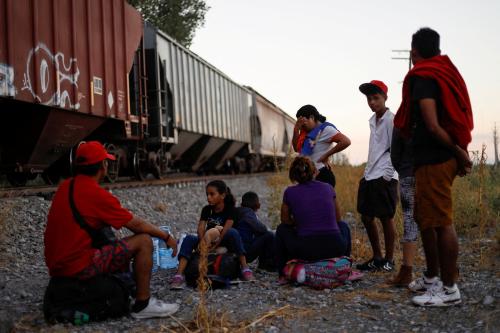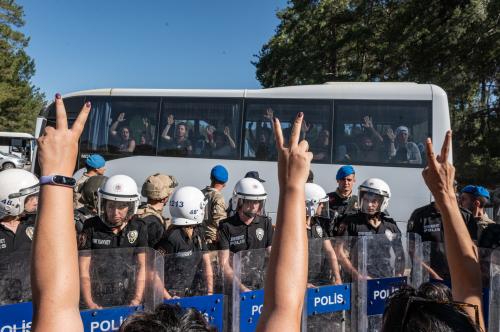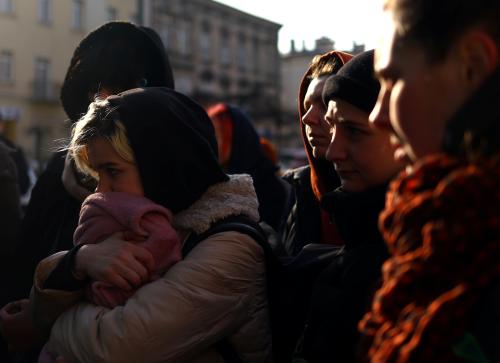I would like to thank the UN Development Programme for organizing, in collaboration with the Government of Turkey, this conference on a subject so timely and important for this country. To begin with, I would like to emphasize that internal displacement affects all regions of the world. At least ten countries in Europe confront this problem as well as many more in the Americas, Asia and Africa. Overall, some 20 to 25 million persons are reported to be forcibly uprooted within their own countries by conflict and human rights violations. Millions more are displaced internally by natural disasters and development projects. United Nations Secretary-General Kofi Annan has described internal displacement as “one of the great human tragedies of our time” because of its “devastating effect on families, cultures, jobs, education, and the security of a stable society.” Whether in a developed or a developing country, forced displacement is a prima facie case of vulnerability, breaking up families, cutting off important social and community ties, terminating employment relationships, depriving people of land and adequate housing, reducing educational opportunities and often depriving people of vital health services and sufficient food, and making the affected people more susceptible to poverty and violence. Even though unemployment, poverty and social problems may affect many persons in a given population, the internally displaced have particular needs and are often found to suffer disproportionately when compared with the rest of the population. The purpose of identifying the internally displaced as a special category is not to confer on them a privileged status but to ensure that their unique needs are addressed along with those of others.
If left unaddressed, the UN Secretary-General has warned, forced displacement will cause “internal instability” and may also spill across borders and “upset external and regional stability.” He has called upon the international community to strengthen its support for national efforts to assist and protect displaced populations. And there are many national efforts being undertaken around the world. National authorities after all have the primary responsibility for meeting the protection, assistance, reintegration and development needs of the internally displaced. In fact one of the basic principles when it comes to internal displacement is the responsibility of the national authorities.
But what exactly does national responsibility mean? Using the Guiding Principles on Internal Displacement as a guide, the Brookings-Bern Project on Internal Displacement has identified twelve steps that governments should consider taking to carry out their national responsibilities toward IDPs.[1] These benchmarks should help government officials and civil society representatives to measure the extent to which national responsibility is being exercised.
1. The first step is Prevention. Governments have a responsibility to try to prevent conditions on their territory that might compel populations to flee. While in some countries this means setting up early warning and rapid response mechanisms, it also means promoting conditions within a society that accord with human rights so that tensions, communal strife and the displacement that generally accompanies such unrest can be averted. In his 2000 Millennium report, the Secretary-General said it well: Preventive strategies must work “to promote human rights, to protect minority rights and to institute political arrangements in which all groups are represented. …Every group needs to become convinced that the state belongs to all people”. Statements and measures that convince different groups that the state belongs to all people can be a good preventive measure of conflict and displacement.
2. Raising National Awareness of the Problem. A government’s public recognition of internal displacement and of its responsibility to address it is the opening step to an effective national response. Public pronouncements, public information campaigns, and statement by a high government official can help build national consensus around addressing the issue. In some countries, public statements can promote reconciliation and encourage solidarity with the displaced. This is important because in many countries, displaced persons suffer from stigmas, whether racial, ethnic, ideological, social – many are from rural areas, or simply because they are displaced.
National information campaigns to be most effective must include central government officials from all branches of government and also extend to local and regional officials and military and police. The campaigns must be developed in consultation with the displaced and actively involve civil society. In this way national responsibility for addressing internal displacement becomes a concept embraced and implemented by all parts of society.
Today’s meeting in Ankara with government officials and civil society is a good example of a readiness on the part of the government to acknowledge the issue and discuss it in the public domain. There should be many more such meetings between the government and civil society. The dissemination in Turkish of the Guiding Principles on Internal Displacement, which is being done cooperatively by the government and the United Nations, is another important example of how a government can acknowledge the problem and its own obligations to help displaced populations.
3. Data Collection. Credible and detailed information on the numbers, locations and conditions of IDPs is essential to the design of effective policies and programs. Because controversies often develop in displacement situations over the nature and scope of the problem, it is useful to turn to independent institutions with known objectivity to establish the facts. It is certainly a best practice that the Turkish government has asked the Institute of Population Studies at Hacettepe University to develop well-documented information on the numbers and situation of the displaced. Respecting the right of the researchers to do their work independently could make this practice a model for other countries to follow.
Data to be truly effective must be disaggregated by age, gender, and other indicators to ensure that the specific needs of vulnerable groups are taken into account in developing policies. In 2001, for example, the Turkish Daily News reported a high rate of suicide among women in cities who had been displaced from their villages in the southeast. It would therefore be important to look into this and collect information about women heads of household and single women, as well as about unaccompanied minors, children, the elderly and persons with disabilities. Such information is valuable to developing responsive programs.
4. Training. Training programs for government officials, parliamentarians, military and police in the Guiding Principles on Internal Displacement often help to ensure that these officials are aware of the rights and needs of the displaced and of their obligations toward them. In May of 2005, a group of deputy governors and other Turkish officials participated in a training workshop in Ankara on the Guiding Principles, organized by the Internal Displacement Monitoring Center of the Norwegian Refugee Council, and which the Representative of the Secretary-General addressed. This is an important step. There needs to be additional training programs for deputy governors and other government officials, for example commissioners in the damage assessment commissions who decide on compensation claims for the displaced as well as the representative of the bar in these commissions. In addition to expanding the number of government officials trained, it is also important to promote training for civil society groups who advocate for the displaced and for the displaced themselves and who can work with the government as implementing partners.
5. A National Legal Framework. Laws on internal displacement have begun to be adopted by a small but growing number of governments. Whether in Georgia in the South Caucasus, Colombia and Peru in the Americas, Iraq in the Middle East, Sri Lanka and the Philippines in Asia, or Uganda and Angola in Africa, legal frameworks have been or are being developed to uphold the rights of IDPs. In some instances, the laws are broadly drawn; in other cases they focus on a specific phase of displacement, such as return and resettlement. What is most important is for governments to study their own internal displacement situations and then examine, against the background of international standards, whether their laws sufficiently address the problem or whether their laws should be revised or new laws adopted. The government of Georgia, for example, amended its law on IDPs because the provision on voting rights was not adequate to the problem and did not comply with international standards. The Turkish Government recently amended its compensation law to allow for more time to file applications.
To provide guidance on the key elements to include in national laws, the Representative of the Secretary-General is currently developing a legislators’ manual, which will encompass issues such as housing, property, employment, social security, education and political participation, within the framework of the Guiding Principles. The UN Secretary-General in his 2005 report, In Larger Freedom, urged member states to commit themselves to promote the adoption of the Guiding Principles through national legislation.
6. A National Policy. A national policy or strategy document is important to explain the government’s overall view of the problem and how it plans to address it. It should be published, widely disseminated and discussed in a transparent process. Policies, like laws, should be based on internationally acknowledged standards such as the Guiding Principles on Internal Displacement. They should be comprehensive, covering IDPs whether forcibly displaced by conflict, natural disaster or development projects and include all phases of displacement from prevention through returns or resettlement. They need to ensure there is no discrimination on grounds of gender or for ethnic or political reasons, or because the IDPs choose to resettle rather than return to their home areas. Indeed, IDPs who resettle in urban areas are also IDPs, but urban IDPs are often overlooked in many countries. Yet they may live in substandard housing, suffer unemployment, cannot afford to send their children to school, may have limited or no access to social security, and may fall below the poverty line. Policies must also address the particular needs of vulnerable groups of IDPs, such as women heads of household, children, elderly people, and disabled people. If policies are to be effective, they should be developed in full consultation with IDPs and civil society and disseminated to IDPs in a language and in a form they can easily understand.
7. Creation of a National Institutional Focal Point. To ensure that policies and programs are not just enunciated but also implemented, it is valuable to have a dedicated office devoted to the issue of internal displacement. While some governments create a new institutional structure, others assign responsibility to an existing government agency, like the Ministry of Interior in Turkey, and may also establish special units within that larger structure. Whatever the arrangement, the body should have staff specifically focused on internal displacement and with sufficient authority to provide leadership in implementing the policy and in coordinating and monitoring the activities of the various government offices involved. They should be trained in issues of internal displacement and their office should have adequate resources to function effectively. In carrying out their work, they should be in close contact with internally displaced persons and with civil society.
8. A Role for National Human Rights Institutions. In countries with national human rights institutions, governments often find that these bodies can support national efforts to address internal displacement. Whether they are human rights commissions or consultative boards, national human rights institutions can provide advice to government bodies, organize national awareness programs, disseminate the Guiding Principles, provide training programs for government officials, receive complaints from individuals and groups and monitor the government’s response. Such institutions need authority, resources and training to carry out such roles but the capacity building is worth the effort. A growing number of national human rights institutions around the world are playing constructive roles in helping governments to deal with internal displacement.
9. Participation of IDPs in Decision-Making. Too many examples exist of policies and plans being developed without consultation with the beneficiaries. Yet top down approaches that exclude consultation with affected communities do not work well. For example, the rebuilding of houses and infrastructure without attention to ensuring access to land, livelihoods and transport, can lead to IDPs not returning to their home areas or not in large numbers. The plans then have to be modified, which is time consuming and costly. Similarly, programs that exclude women’s participation can lead to women and their families becoming impoverished, susceptible to exploitation and undermining of development. Consultation, however, cannot be a one-time event but built into the planning and reconstruction process. It is noteworthy that UNDP has been working with the government of Turkey in developing a program on internal displacement that will bring together civil society, IDPs, local communities and provincial administrators to work out how best to address the needs of IDPs.
10. Supporting Durable Solutions. This means that governments are expected to facilitate the voluntary and safe return of the displaced to their homes or places or habitual residence or help them resettle in another part of the country. It must be reiterated that not all IDPs may wish to return home; those who do not are also entitled to receive assistance to help them integrate into society.
In the case of returns, certain conditions need to be met, such as creating a secure environment, which may involve disarming and demilitarizing areas, removing land mines and ensuring safety for people who return — in short, removing the obstacles to return. Sustainability is another important condition for successful return, which means the restoration of basic services, housing projects, employment programs and the rebuilding of infrastructure and agriculture. Although often neglected around the world, psychosocial programs are needed to deal with trauma and enable people to move on with their lives. So too are programs of reconciliation between those displaced and those who have remained. For IDPs who do not return home, but merge into urban areas, help may be needed with housing, skills training, employment opportunities and access to health care and education. Whether there is return or resettlement, cooperation will be needed between central and municipal authorities. To avoid tensions and resentments with host communities, community-based programs are valuable, which target areas with large numbers of displaced persons but also help other populations in need.
Assisting the displaced to recover their property and possessions or obtain compensation or reparation is another important way to achieve a lasting solution. Turkey’s 2004 compensation law is a positive step toward addressing the consequences of displacement. Laws, however, often need to be accompanied by information campaigns, guidelines so that the displaced know how to interpret and use the laws effectively, and monitoring and review mechanisms.
Truly durable solutions must also include efforts to address the fundamental social, economic and political issues as well as the regional disparities that are often at the root of most conflict and displacement. In addition to infrastructure, trust needs to be reestablished between the state and affected communities, and societies put back together again on a stronger foundation based on human rights.
11. Allocation of adequate resources. This means a readiness to devote resources to reconstruct in areas of return and also extend humanitarian and development aid to IDPs who resettle in other areas of the country. When governments do not have sufficient capacity to carry the financial burden alone, they can and should turn to the international community for assistance to reinforce national capacity. Indeed, arrangements with international financial institutions and aid agencies are made more possible when governments show they are making a priority of the issue and allocating their own resources to it.
12. Cooperation with International and Regional Organizations to Reinforce National Efforts. The 2002 mission to Turkey of Francis Deng, Representative of the UN Secretary-General on Internally Displaced Persons, signaled a willingness on the part of the government to cooperate with the international community on the subject of internal displacement. In 2003, at the Organization for Security and Cooperation in Europe, the government supported recognition by the Ministerial Council of the Guiding Principles as a “useful framework” for the work of the OSCE. The government also welcomed the current Representative of the Secretary-General, Dr. Kälin, when he paid a working visit in 2005 and made recommendations to the government. And as is evidenced today, the government is giving support to the UN Development Program’s initiatives on internal displacement in Turkey. A genuine partnership here could prove a good example of cooperation with the international community to strengthen national efforts. There is also a relationship of the government to the EU and European Commission on this issue.
In conclusion, internal displacement is a complex and difficult subject for governments to address. It generally reflects divisions and tensions within societies, which often continue after periods of conflict have ended. The Turkish government has been gaining the reputation of being willing to embark upon a path to address the issue but like in other countries, a great deal of energy, political will, resources and commitment will be required to achieve concrete results. Yet the rewards can be great. Governments that address the problem enhance unity and stability within their countries and establish a strong foundation for the future.
* This statement was also presented at a Ministry of the Interior Colloquium in Ankara, Turkey, February 24, 2006.
[1] Addressing Internal Displacement: A Framework for National Responsibility, The Brookings Institution-University of Bern Project on Internal Displacement, April 2005.



Commentary
National Responsibilities: Providing an Adequate Response to IDP Needs
February 23, 2006